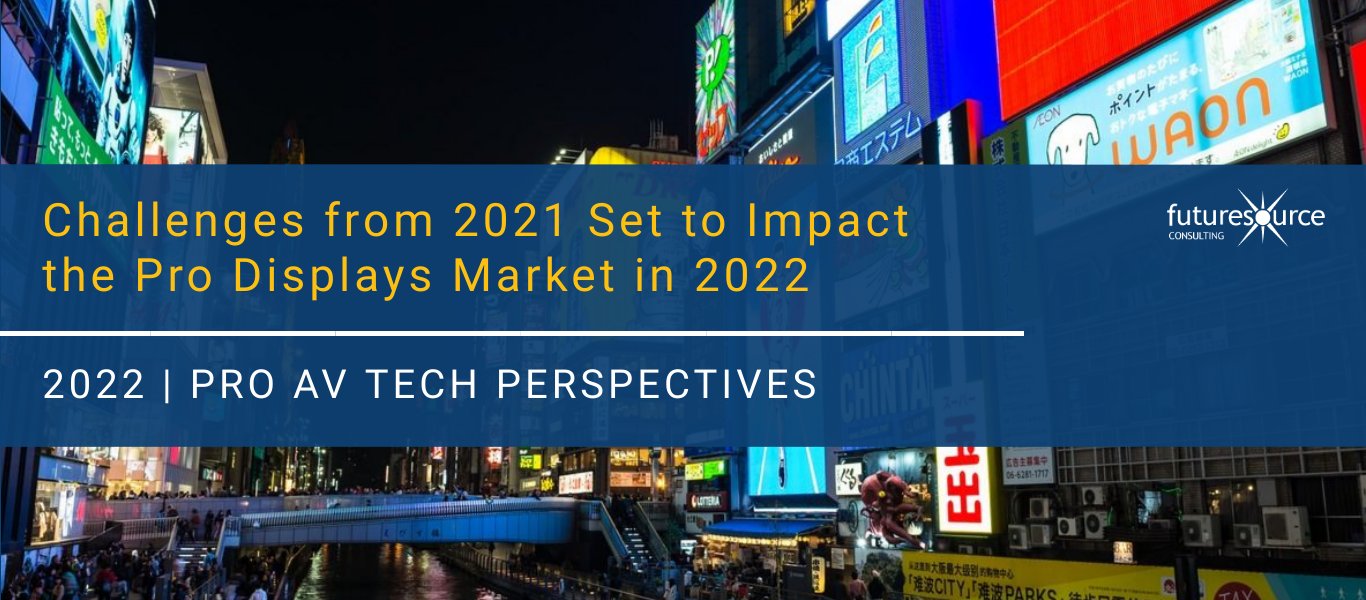
Commercial Flat Panel Display Volume up 20.1% Year-On-Year, Projection Flat: Futuresource
March 22, 2022 by Dave Haynes
Year-on-year volume global sales for commercial flat panel displays jumped 20.1% in 2021, according to new data from the UK research firm Futuresource Consulting, but commercial projector growth grew by just 0.2%.
Given these numbers are tied to an exceptionally weird period of lockdowns, deferred projects and supply chain shortages, they may not be indicative of all that much, in terms of trends.
Futuresource says as much:
While some manufacturers have been quick to capitalise and offer fresh solutions, other technology types were left behind and their decline accelerated. Ultimately, until supply-side issues are ironed out, it will be difficult to gauge an accurate picture of the market.
Many display vendors have struggled to fully absorb the impact of the chip shortage, as well as financial pressure from increased freight costs – these are set to continue throughout 2022 into 2023. Vendors have reacted to component shortages by focusing on high-value products to claw back margins. These factors have contributed to demand – and supply-side shifts towards the high-value segments of the market.
The turbulence of the pandemic has hastened the decline in many worldwide projection market areas. A relatively flat growth rate shunned an anticipated recovery, leaving volume over 30% smaller than before the pandemic. Key markets of Mainstream B2B and B2B Short Throw are not expected to see their pre-pandemic peaks. While mainstream B2B, categorised by having below 6K LMN, has suffered from office requirements of higher-brightness solutions.
B2B Short Throw projection is operating in education markets, which have accelerated their shift to IFPD (Interactive Flat Panel Display). With ample government funding available – $130 billion has been issued for new tech in the US alone – schools are less price-sensitive and wanting to spend on the ‘newest’ futureproofed technology.
Forecasted CAGR rates of IFPD in fact, inversely mirror the decline of projection. However, the less-saturated markets of Eastern Europe, LATAM and South-East Asia still have a large appetite for projection technology. Though, these can be more volatile and offer a lower price tag.
Large venue and installation represent the smallest segment by volume but is highly prized. At over $2 billion, it is the second most valuable projection segment – soon expected to eclipse mainstream B2B. Brands that have invested in this segment have generally fared better in 2021 than those that did not.
The rise of immersive art exhibitions (the most popular being The Van Gogh Experience) aim to bring in new audiences using projection. A series of high-brightness projectors work in tandem to produce 360-degree digital animations. This success has been a big contributor to value remaining strong, even as other segments decline.
Despite global chip shortages and supply constraints, the global commercial flat panel market grew by a fifth YoY in 2021. A considerable proportion of demand was driven by the education vertical, particularly interactive displays, with government funding facilitating the investment in schools.
Looking to the future, collaboration within hybrid working environments is set to be the focus for many flat panel display vendors. While the education space has driven growth up to now, attention is shifting to corporate environments. There is also increased focus on dvLED displays, with new brands getting involved, and microLED is on the horizon too. Vendors here are focused on expanding ranges and educating the industry’s channel on its benefits as more a premium, customisable display option.
As the world continues to move into a post-pandemic phase, with shopping and travel slowly resuming, attention is also shifting back to digital signage applications, Professional displays were relied up on for health and safety messaging during the pandemic, but demand for traditional uses cases is returning. Growing confidence from the advertising industry to invest in DooH (digital out of home) displays will be a core driver for growth. But so too will appetite for new signage in office spaces, away from the meeting room, to help businesses pass information to employees.
Very interesting. There are lots of reasons to think projection will be more widely used because the systems are less costly, smaller and last longer now that laser light engines have taken over from lamps. Projection-mapping exhibitions – touring and permanent – are interesting, but there’s not that much scale. But there’s lots of interesting things to do in retail and museums with projection that works with physical objects.



Leave a comment